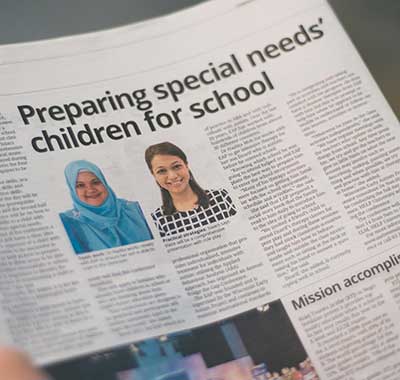
[Feature Article] The Star Newspaper: Preparing Special Needs’ Children for School
On November 8th, EAP Malaysia was featured in the Star newspaper under the Schools section. In conjunction with our Bridge the Gap 2015 conference, Jochebed Isaacs, our director, along with Dr. Hazlita, one of our parents, spoke about preparing and transition children with autism to school. Dr Hazlita also shared her personal journey, challenges and joy in transitioning her son with autism to a mainstream school.
—
Preparing Special Needs’ Children For School
Published in: The Star
Published on: 8th November 2015
The Early autism Project (EAP) Bridge the Gap 2015 Conference: the School Edition hopes to answer questions on how to prepare a child with special needs for school.
EAP Malaysia director and clinical psychologist Jochebed Isaacs said there will be a comprehensive presentation with practical strategies that will be role played during the conference to address the four main areas a child requires to be successful in school.
There are adaptive skills, academic skills, social skills and behaviour-regulation skills.
The first half of the day will be on identifying the prerequisite skills of a child and the second half of the conference will be on how to teach these skills to a child with autism or other special needs.
“By the end of conference, a participant will have a clear idea on what is expected of a child with special needs to be successful in school as well as how to prepare the child in these areas to be able to transition successfully to school. It is important to identify the objective of transitioning a child to school,” she said.
Primarily, she added, it is for the child to have a meaningful learning experience.
Therefore, a child needs to have the ability to cooperate, imitate and attend in a group setting as this is how they will be able to learn in a group environment.
On who should attend, she said all parents and teachers of children with autism and other special needs will find this conference beneficial.
This will apply to families who already have children in school or who are thinking about their child’s future education plans.
“Our conferences are designed to be practical and participants will receive substantial input in the topic discussed,” she added.
Since 2013, the EAP which is a professional organisation that provides individualised, intensive treatment for individuals with autism utilising the Applied Behavioural Analysis (ABA) approach, has organised an Annual Bridge the Gap conference.
The EAP was founded and is supervised by the Wisconsin Early Autism Project and continues to maintain international standards of practice of ABA and with individuals with autism. Over the last 10 years, EAP has worked with hundreds of children from almost 30 different countries.
Dr Hazlita Moh Isa works with EAP to get intensive therapy for her son Dzarif who is autistic, before he entered school.
“Knowing which school he was going to attend helped us and EAP plans the best way to prepare him to enter the school environment. Many of his therapy activities were focused on getting him familiar with the school environment. schedule and activities,” she said.
She said that EAP prepared a social story book that the family read to him daily to introduce him to the idea of going to school.
“We invited a friend’s child to attend Dzarif’s therapy classes for peer play and during these sessions they had mock classroom scenarios and taught him how to behave inside and outside the class environment such as sitting at the desk or raising his hand to answer a question,” she said.
Drarif, she added, is currently coping well in school.
“He is integrating and taking part in activities and teachers are satisfied with his progress. He does have a shadow therapist from EAP with him but this is to prompt or help him when he appears to be unable to understand or follow certain lessons, activities or instructions. Otherwise he joins in the class activities independently,” she said. “We have regular meetings with the teachers who update us with things from school. Any time possible, we try and get the teachers to give us little hints on what the next lessons may involve such as describing, making, painting something and when possible, we try and practice with him at therapy or at home,” she added.